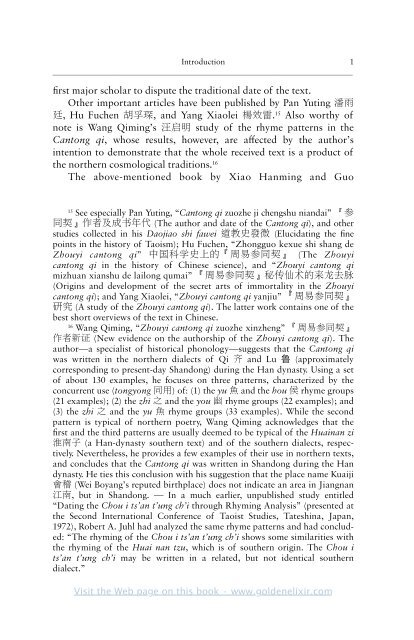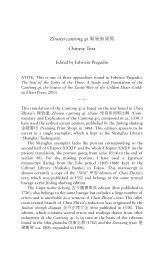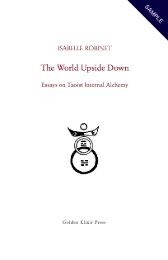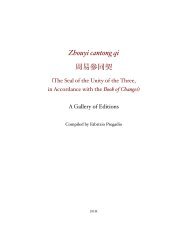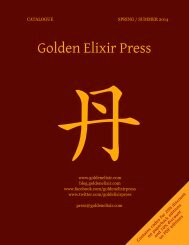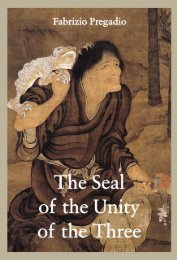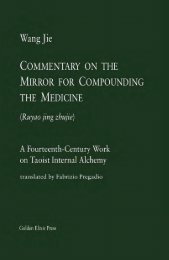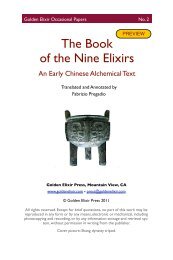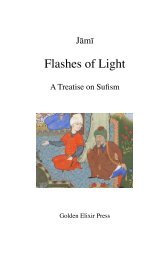The Seal of the Unity of the Three â Vol. 2 - The Golden Elixir
The Seal of the Unity of the Three â Vol. 2 - The Golden Elixir
The Seal of the Unity of the Three â Vol. 2 - The Golden Elixir
- No tags were found...
You also want an ePaper? Increase the reach of your titles
YUMPU automatically turns print PDFs into web optimized ePapers that Google loves.
Introduction 1<br />
————————————————————————————————————————— 1<br />
first major scholar to dispute <strong>the</strong> traditional date <strong>of</strong> <strong>the</strong> text.<br />
O<strong>the</strong>r important articles have been published by Pan Yuting 潘 雨<br />
廷 , Hu Fuchen 胡 孚 琛 , and Yang Xiaolei 楊 效 雷 . 15 Also worthy <strong>of</strong><br />
note is Wang Qiming’s 汪 启 明 study <strong>of</strong> <strong>the</strong> rhyme patterns in <strong>the</strong><br />
Cantong qi, whose results, however, are affected by <strong>the</strong> author’s<br />
intention to demonstrate that <strong>the</strong> whole received text is a product <strong>of</strong><br />
<strong>the</strong> nor<strong>the</strong>rn cosmological traditions. 16<br />
<strong>The</strong> above-mentioned book by Xiao Hanming and Guo<br />
15<br />
See especially Pan Yuting, “Cantong qi zuozhe ji chengshu niandai” 『 参<br />
同 契 』 作 者 及 成 年 代 (<strong>The</strong> author and date <strong>of</strong> <strong>the</strong> Cantong qi), and o<strong>the</strong>r<br />
studies collected in his Daojiao shi fawei 道 教 史 發 微 (Elucidating <strong>the</strong> fine<br />
points in <strong>the</strong> history <strong>of</strong> Taoism); Hu Fuchen, “Zhongguo kexue shi shang de<br />
Zhouyi cantong qi” 中 国 科 学 史 上 的 『 周 易 参 同 契 』 (<strong>The</strong> Zhouyi<br />
cantong qi in <strong>the</strong> history <strong>of</strong> Chinese science), and “Zhouyi cantong qi<br />
mizhuan xianshu de lailong qumai” 『 周 易 参 同 契 』 秘 仙 术 的 龙 去 脉<br />
(Origins and development <strong>of</strong> <strong>the</strong> secret arts <strong>of</strong> immortality in <strong>the</strong> Zhouyi<br />
cantong qi); and Yang Xiaolei, “Zhouyi cantong qi yanjiu” 『 周 易 参 同 契 』<br />
研 究 (A study <strong>of</strong> <strong>the</strong> Zhouyi cantong qi). <strong>The</strong> latter work contains one <strong>of</strong> <strong>the</strong><br />
best short overviews <strong>of</strong> <strong>the</strong> text in Chinese.<br />
16<br />
Wang Qiming, “Zhouyi cantong qi zuozhe xinzheng” 『 周 易 参 同 契 』<br />
作 者 新 (New evidence on <strong>the</strong> authorship <strong>of</strong> <strong>the</strong> Zhouyi cantong qi). <strong>The</strong><br />
author—a specialist <strong>of</strong> historical phonology—suggests that <strong>the</strong> Cantong qi<br />
was written in <strong>the</strong> nor<strong>the</strong>rn dialects <strong>of</strong> Qi 齐 and Lu (approximately<br />
corresponding to present-day Shandong) during <strong>the</strong> Han dynasty. Using a set<br />
<strong>of</strong> about 130 examples, he focuses on three patterns, characterized by <strong>the</strong><br />
concurrent use (tongyong 同 用 ) <strong>of</strong>: (1) <strong>the</strong> yu 魚 and <strong>the</strong> hou 侯 rhyme groups<br />
(21 examples); (2) <strong>the</strong> zhi 之 and <strong>the</strong> you 幽 rhyme groups (22 examples); and<br />
(3) <strong>the</strong> zhi 之 and <strong>the</strong> yu 魚 rhyme groups (33 examples). While <strong>the</strong> second<br />
pattern is typical <strong>of</strong> nor<strong>the</strong>rn poetry, Wang Qiming acknowledges that <strong>the</strong><br />
first and <strong>the</strong> third patterns are usually deemed to be typical <strong>of</strong> <strong>the</strong> Huainan zi<br />
淮 南 子 (a Han-dynasty sou<strong>the</strong>rn text) and <strong>of</strong> <strong>the</strong> sou<strong>the</strong>rn dialects, respectively.<br />
Never<strong>the</strong>less, he provides a few examples <strong>of</strong> <strong>the</strong>ir use in nor<strong>the</strong>rn texts,<br />
and concludes that <strong>the</strong> Cantong qi was written in Shandong during <strong>the</strong> Han<br />
dynasty. He ties this conclusion with his suggestion that <strong>the</strong> place name Kuaiji<br />
會 稽 (Wei Boyang’s reputed birthplace) does not indicate an area in Jiangnan<br />
江 南 , but in Shandong. — In a much earlier, unpublished study entitled<br />
“Dating <strong>the</strong> Chou i ts’an t’ung ch’i through Rhyming Analysis” (presented at<br />
<strong>the</strong> Second International Conference <strong>of</strong> Taoist Studies, Tateshina, Japan,<br />
1972), Robert A. Juhl had analyzed <strong>the</strong> same rhyme patterns and had concluded:<br />
“<strong>The</strong> rhyming <strong>of</strong> <strong>the</strong> Chou i ts’an t’ung ch’i shows some similarities with<br />
<strong>the</strong> rhyming <strong>of</strong> <strong>the</strong> Huai nan tzu, which is <strong>of</strong> sou<strong>the</strong>rn origin. <strong>The</strong> Chou i<br />
ts’an t’ung ch’i may be written in a related, but not identical sou<strong>the</strong>rn<br />
dialect.”<br />
Visit <strong>the</strong> Web page on this book • www.goldenelixir.com


